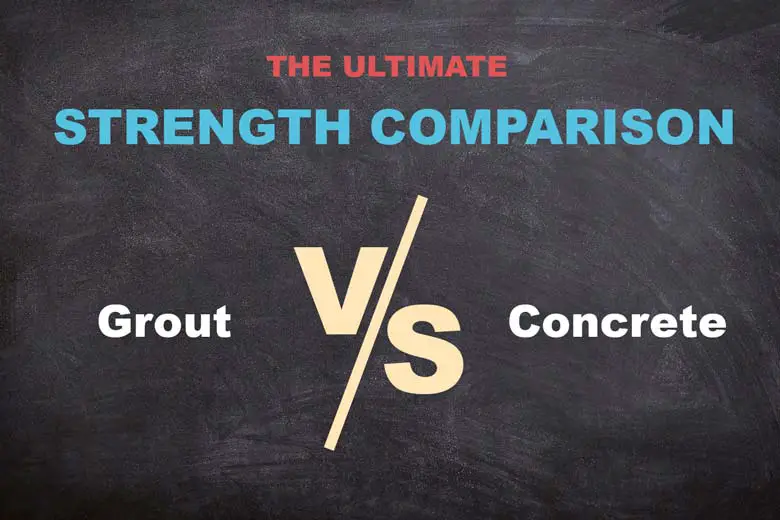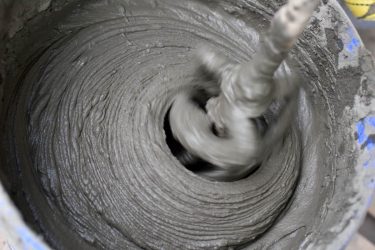Grout and concrete are both strong, usually cement-based mixtures that harden when mixed with water. Both are common in construction projects, large and small. But how do these sturdy mixtures compare on the strength scale?
Grout and concrete are usually about the same in strength, except in the case of Ultra-High Performance Concrete, which is new to the market and ten times as strong as either traditional concrete or grout. Concrete has greater compression strength than grout (7,500 vs. 5,000 psi, respectively).
The grout vs. concrete debate is still ongoing in the construction industry. To learn more about the relative strength of grout and concrete and how to measure it, read on!

Table of Contents
Comparing Grout and Concrete
Grout and concrete are both thick, liquid-like substances that harden to bind objects together or form a flat surface. Each is made of a mix of minerals to become strong and adhesive. The substances are typically sold as a powder, then made into an adhesive when mixed with water. At this point, once it solidifies, it solidifies permanently.
What Is Grout?
Grout is considered a kind of mortar. But where the traditional mortar is made from fine sands, water, cement, and lime, grout is made from only fine sands, water, and cement — without the lime. Lime adds durability to the mix, making grout relatively less durable than other mortars. It also has lower water content and doesn’t flow as much as other mortars.
What Grout Does (& How It’s Made)
That said, grout does have a higher water content than other binding materials because its purpose isn’t to do the heavy lifting of binding but rather to fill gaps. It needs to be able to spread out to fill every crevice.
Grout can be bought as a powdered mixture, which activates the cement after mixing with water. You can mix it with a hoe or shovel if you need a smaller amount, or use a large cement mixer if you need more. See SimpleGrout’s Pre-Mixed Grout as an example.
It can also come in a wide variety of colors. You can either purchase a mix that’s already been mixed with a pigment, or you can purchase a colorant like the Aqua Mix Grout Colorant. Aqua Mix sells a wide range of colors, most of them mixed to look like a kind of natural stone.
Grout is commonly used to fill the gaps between ceramic tiles, a job too delicate for other kinds of cement-based pastes. It is sometimes also used to adhere the tiles themselves to the floor, but a stronger and more durable mortar can do this without breaking the tiles. And finally, grout can be used in bigger construction projects as an adhesive, like when attaching wall elements.
Types of Grout
If you’re working with grout and tiles, you’ll find a few different varieties, depending on the size of the gaps that need to be filled and the kind of installation you’ll be doing. When gaps between tiles are ⅛ inch (0.32 cm) wide or less, you’ll need to use unsanded grout, where larger gaps require sanding. Epoxy grout is used more when the tiles may be exposed to acid or oils.
When the grout is used in bigger construction projects, builders may use a fine or a coarse grout, determined by the aggregate size used in the mixture. Coarse grouts are typically more economical to use for a big project. Epoxy grout can also be useful here because it tends to be stronger than cement-based grout.
Epoxy grout is the number one choice for binding heavy equipment to the floor because it is strong. It also lasts for a very long time and is impervious to most things, including water. This means that you don’t need to worry about the freezing and thawing of water inside an epoxy grout structure.
What Is Concrete?
Concrete is made from cement, sand, and gravel, or other fine and coarse aggregate. It starts as a powdered mix, later mixed with water to activate the cement to harden. Concrete can be bought in small quantities for patches, like the Red Devil Pre-Mixed Concrete tub, but it is most commonly used in large quantities to make big slabs used in construction.
What Concrete Does (& When It’s Used)
These slabs are used to build foundation walls, patios, and many other structures. It is incredibly versatile because its semi-liquid form after mixing allows it to fit into any mold or shape and then dry into a rock-hard material. Sometimes, an added metal reinforcement like wire mesh or rebar is added for extra strength, minimizing any cracking. However, concrete is very hard on its own.
Concrete should be workable and resistant to freezing and thawing. The water and cement should be mixed in equal parts, and both minimized for cost-effectiveness. This is possible if you use a large-sized aggregate mix with some stiffness to it.
Types of Concrete
There are several kinds of cement used in different contexts and temperatures. These are usually created by the inclusion of additives to the mixture. For example, you can add an accelerant like calcium chloride to encourage the concrete to set more quickly.
In hot weather, you might want to use a retarding admixture to delay the setting time of concrete. This can also be useful when you’re building something with exposed aggregate, which needs more finishing work.
Some builders choose to swap out 15-30% of the cement in their mix for fly ash, a byproduct of coal plants. This decreases the amount of heat developed internally in the concrete and makes it easier to work with and finish.
Air entraining admixtures are added to concrete when it’s likely to be exposed to freezing temperatures and deicing salts. These admixtures trap microscopic air bubbles in the concrete, creating room for water to expand when it freezes inside the concrete. Without air-entraining admixtures, this freezing process can crack your concrete.
Some concrete mixtures include a water-reducing admixture that decreases the amount of water needed to activate the mix. Usually, these admixtures reduce the amount of water needed by 5 to 30%, with the more effective kinds being more expensive.
Finally, some mixtures include integrated fibers, creating what’s called Ultra-High Performance Concrete (UHPC). UHPC fibers are made from stainless steel, fiberglass, basalt, or steel, and they dramatically increase the strength of the concrete. Although UHPC is still very new, it is already being used in some infrastructure projects in the United States.
Grout vs. Concrete: Similarities and Differences
Both grout and concrete are typically made from cement, sand, and water, but concrete also includes gravel or another aggregate for extra strength and roughness. Grout also tends to be made with a finer sand than concrete, and in general, is thinner and more spreadable than concrete.
Usually, concrete is used to make solid slabs for things like floors and walls, where grout is used more like an adhesive to mount tiles or fixtures to the floor or wall. Both need to withstand wear and tear without giving, cracking, or breaking, and both can be very strong.
The strength of either material varies depending on how it’s made. For example, grout made with epoxy resin instead of cement will be stronger than your average concrete. Still, concrete can also be made very strong by slowing down the solidification process.
Other Cement-Based Mixtures
Cement can be used on its own as a binding agent, but it isn’t as strong on its own as it is when it’s mixed with an aggregate like gravel or sand. Cement is made from limestone, clay, silica, and shells, with the largest ingredient being limestone. It is sometimes referred to as Portland cement because it was first made on the island of Portland off the coast of England.
It is used as the basis of mortar, a substance very similar to grout. Mortar is similar to grout but more durable due to the addition of lime. It is also used to hold together bricks, stones, and other masonry materials.
Stucco is another cement-based mixture made from cement mixed with sand, lime, and water and spread as a thin coating on a house’s exterior. It is considered a finishing coat in the construction process, used to create a smooth surface to paint on. Stucco is not very strong and will break under stress.
How Is Strength Measured?
There are many ways to test the strength of concrete, grout, and other cement-based substances. These include compressive strength and tensile strength, as well as flexural strength. Each of these refers to how well the substance maintains its form under pressure.
Compressive Strength
Compressive strength refers to the ability to withstand the pressure that decreases the size of the sample. It’s measured in pounds per square inch or psi. This psi value can be determined through a test where a cylinder of the substance in question is placed in a special machine and then compressed until it breaks.
Compressive strength is typically measured after 28 days of solidification after the substance has had the chance to harden to its maximum potential.
Tensile Strength
Tensile strength refers to the ability to resist cracking or breaking under the tension of being stretched or pulled. Testing tensile strength is difficult, and the value of an object’s tensile strength is typically determined indirectly by testing other kinds of strength, like flexural strength or split tensile strength.
Flexural Strength
Flexural strength refers to the ability to resist bending under stress and is often used as an indirect measure of tensile strength. This test should be conducted when the material being tested is wet before it has hardened. For this reason, compressive strength is more likely to be used as a measure of strength for cement-based substances.
Factors That Influence Strength
Whether you’re working with grout or concrete, the strength will be affected by some common factors. For example, adding extra water to the mixture will create a weaker product. In fact, the proportion of all ingredients matters to the strength of the final product.
Mixing time also influences the strength of the final product. If concrete or grout is over-mixed, it can cause the water to evaporate, creating fine particles that make the mixture harder to work with and weaker in the long run.
Keeping the concrete or grout wet for a longer period of time will enhance its strength, which is part of the reason why it’s important to be vigilant about using admixtures and other precautions in very cold or hot temperatures.
As cement-based solids age, they tend to increase in strength dramatically after the first 28 days and then again after the first year.
How Much Strength Is Too Much Strength?
In certain conditions, builders will actually choose the weaker of two materials to match the strength of various materials being used in a project. An imbalance in material strength can lead to stress and breaking in the weaker areas.
Some building guidelines even specify a maximum strength for grout and concrete in different settings. For example, the Masonry Standards Joint Committee sets the minimum and maximum standards for the compressive strength of grout and concrete, depending on the other materials being used.
Which Is Stronger: Grout or Concrete?
The relative strength of grout and concrete depends on the kind of grout or concrete you’re using and whether you’re talking about strength in an everyday construction setting or in a laboratory setting.
How Strong Is Grout?
Grout typically has a compressive strength of about 2,000– 5,000 psi in common construction settings. Builders working with grout will generally try to match the strength of the grout to the strength of the rest of the masonry so that the strength of the final product is not unbalanced.
The strongest kind of grout is epoxy grout or a grout mixed with resin and a hardener instead of cement. This kind of grout can reach a strength of 12,000 psi and is used to bind heavy machinery and other equipment to the floor.
Traditional cement grout has a tensile strength of about 870 psi or about 20-40% of its compressive strength.
How Strong Is Concrete?
The strength of concrete depends on its shape and size, as determined by the kind of project it’s being used for. Slabs that sit on the ground typically have a compressive strength of 3,500 to 4,000 psi, with 4,000 psi being the minimum necessary for pavement. Concrete walls, columns, and bridges have a strength between 3,000 to 5,000 psi.
Note that concrete structures in colder climates require a higher compressive strength to withstand freezing and thawing cycles. In normal construction settings, the maximum compressive strength you can find in concrete is about 7,500 psi. But in laboratory settings, the upper limit of concrete strength is more like 16,000 psi.
The tensile strength and flexural strength of concrete tend to be 10-15% less than its compressive strength, at about 300-700 psi, which is why concrete structures are often reinforced with materials that have a higher tensile strength like steel.
UHPC is even stronger, with a compressive strength of about 20,000-50,000 psi. Its tensile strength and flexural strengths are also greater, both typically measured between 300 and 700 psi.
Related article: Is Cement Stronger Than Concrete?
How They Compare
In normal construction settings, grout and concrete have about the same strength, hitting a maximum of about 5,000 psi. However, you’ll find stronger versions of both grout and concrete in laboratory settings and in cases where heavy machinery is involved. In factory settings, grout can be even stronger than any concrete used in construction, reaching 12,000 psi.
But, concrete can be made to be even stronger in laboratory settings, reaching a psi of 16,000. And even though the maximum strength of grout and concrete in common settings is about the same, builders do use a lower minimum strength when working with grout than they do with concrete.
Ultimately, builders will try to use materials of about the same strength throughout an entire project to avoid imbalances that could cause breaking down the line.
How Do Other Building Materials Compare?
When considering the relative strength of grout and concrete, it’s helpful to know how strong other similar materials are for context. See the following chart for reference points of compressive and tensile strength, measured in different building materials:
| Material | Compression Strength | Tensile Strength |
| Bricks, hard | 12,000 psi | 400 psi |
| Bricks, light | 1,000 psi | 40 psi |
| Brickwork, common | 1,000 psi | 50 psi |
| Brickwork, high quality | 2,000 psi | 300 psi |
| Granite | 19,000 psi | 700 psi |
| Limestone | 9,000 psi | 300 psi |
| Sandstone | 9,000 psi | 300 psi |
| Slate | 14,000 psi | 500 psi |
| Trap rock | 20,000 psi | 800 psi |
Conclusion
Grout and concrete are usually about equal in strength, but there is a new Ultra-High Performance Concrete on the market that can be as much as ten times stronger than either traditional concrete or grout. However, maximum strength is not always desired in building projects, and different needs are met by grout and by concrete.



